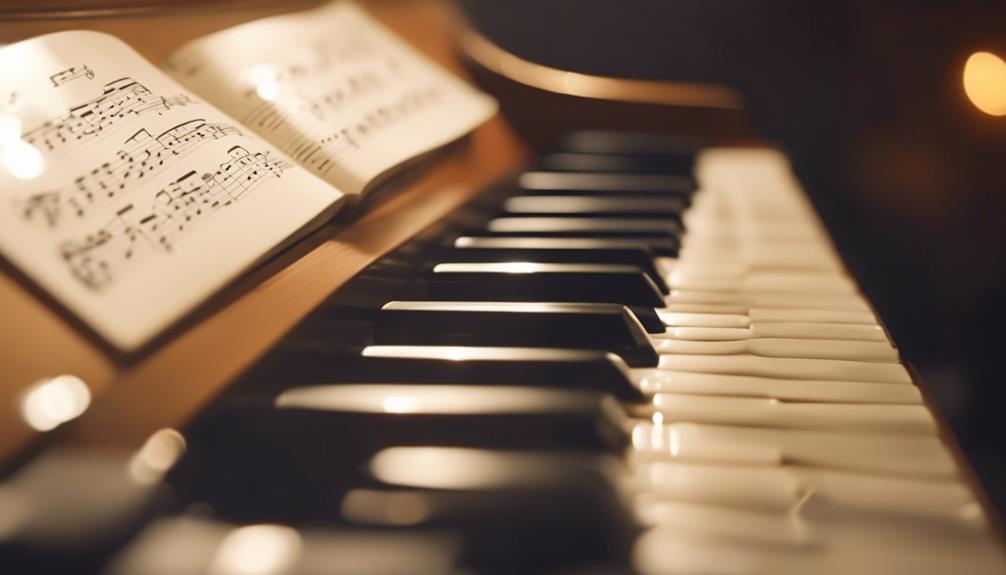When you start exploring piano chord progressions, you’ll quickly realize how they form the backbone of countless songs and musical pieces.
Understanding diatonic chords and primary chords is just the beginning. These foundational elements pave the way for more complex structures and creative possibilities. Imagine crafting your own unique progressions or altering existing ones to add a personal touch to your music.
Whether you’re a beginner or looking to enhance your skills, there are essential tips and resources to support your piano journey. But what exactly makes a progression stand out and keep listeners engaged?
TL-DR
- Understand diatonic chords and primary chords (I, IV, V) for harmonizing within a key.
- Master common progressions like I-IV-V-I, I-V-vi-IV, and ii-V-I to enhance musical composition.
- Experiment with chord inversions and voice leading for smoother transitions between chords.
- Use advanced techniques like diminished chords, slash chords, and extensions to enrich progressions.
- Access free video lessons and resources to build foundational skills and confidence in playing chord progressions.
Understanding Chord Progressions

To understand chord progressions, you need to grasp how sequences of chords form the harmonic and narrative structure of a song. Chord progressions are the backbone of music, providing the essential framework that supports the melody and rhythm.
When you listen to popular songs, you often hear recurring patterns of major and minor chords that create a sense of movement and emotion. A chord progression in a specific key can evoke distinct feelings. For instance, major chords often sound bright and happy, while minor chords convey a more somber or reflective mood.
By mastering these progressions, you’ll be able to play a wide array of songs and even compose your own. In piano lessons, you’ll frequently encounter popular progressions like the I-V-vi-IV sequence found in many pop songs or the ii-V-I progression commonly used in jazz.
These patterns aren’t just random; they follow a logical structure that resonates with our musical sensibilities. Recognizing and understanding these progressions helps you anticipate chord changes and enhances your ability to play by ear.
Diatonic Chords
Diatonic chords are the building blocks of music within a specific key, giving you a harmonious framework to create beautiful chord progressions. These chords naturally occur within a scale and consist of both major and minor chords that align with the scale’s notes.
When you’re working within the key of A minor, for instance, understanding these diatonic chords will help you craft progressions that sound cohesive and pleasing.
In any key, major chords are represented by uppercase Roman numerals, while minor chords use lowercase. For example, in the key of A minor, the diatonic chords are Am (i), Bdim (ii°), C (III), Dm (iv), Em (v), F (VI), and G (VII).
Each of these chords plays a specific role in creating the overall mood and harmony of your music.
Understanding diatonic chords is essential for building effective chord progressions. They ensure your chords harmonize well with each other, providing a stable foundation for more complex musical ideas.
Whether you’re composing a simple melody or an intricate piece, starting with these diatonic chords will set you up for success. Keep exploring the key of A minor and experiment with different combinations to discover your unique sound.
Primary Chords

In music theory, primary chords I, IV, and V are foundational for creating harmonious and effective chord progressions. These primary chords, also known as the tonic (I), subdominant (IV), and dominant (V), are essential for harmonizing any note in a scale. By understanding and using these chords, you can craft chord progressions that effectively support and enhance your melodies.
The I chord serves as the tonic, providing a sense of home and stability. The IV chord, known as the subdominant, offers a sense of movement away from the tonic, while the V chord, or dominant, creates tension that resolves back to the tonic. This interplay between stability, movement, and tension is critical in developing engaging musical compositions.
Primary chords cover all seven notes of a scale, making them versatile tools in your musical toolkit. Major chords are notated with uppercase Roman numerals, while minor chords use lowercase. This notation helps you quickly identify and use primary chords in any key.
Common Chord Progressions
Building on your understanding of primary chords, let’s explore how these and other chords form common progressions that shape countless songs across various genres.
One of the most fundamental piano chord progressions is the I-IV-V-I progression. This progression is prevalent in many classical, pop, and rock songs, creating a sense of resolution and completeness.
Another widely used progression is the I-V-vi-IV. This sequence has been the backbone of countless hit songs and is a favorite in pop music. It creates a powerful emotional arc, making it perfect for songwriting and connecting with listeners on a deeper level.
The ii-V-I progression is essential in jazz and blues. It’s a staple for improvisation, offering a smooth and sophisticated harmonic movement that feels natural and inevitable. By mastering this progression, you can enhance your piano improvisation skills and bring a jazzier feel to your playing.
Popular Progressions

When diving into popular progressions, you’ll find certain sequences that have shaped the sound of modern music. One of the most common is the I-IV-V-I progression, which creates a strong resolution and is prevalent across various genres. This sequence often appears in both major and minor keys, providing a familiar and satisfying conclusion to many songs.
Another widely-used progression is the I-V-vi-IV progression, famously known as the ‘four-chord progression.’ It’s a staple in popular music, appearing in countless hits due to its appealing and versatile sound. You’ll often find this progression in major keys, offering a bright and uplifting feel.
In jazz, the ii-V-I progression is fundamental. This sequence is essential for jazz improvisation and compositions, offering a smooth and sophisticated shift between chords, typically in major keys.
The 12-bar blues progression is essential in blues music. This classic pattern uses the I-IV-V chords in a specific order, creating a recognizable and emotionally resonant structure.
Lastly, the Andalusian Cadence progression, common in flamenco music, follows a descending pattern of vi-V-IV-III. This progression is typically found in minor keys, adding a dramatic and passionate flair.
Understanding these popular piano chord progressions will enhance your ability to play and compose music effectively.
Altering and Passing Chords
When you alter chords or use passing chords, you enhance your musical flow and add harmonic interest to your progressions.
These techniques keep your playing dynamic and engaging, preventing your music from sounding monotonous.
Enhancing Musical Transitions
Mastering altering and passing chords can greatly enhance the flow and excitement of your piano chord progressions. By altering chords, you’re changing their structure or voicing, creating smoother connections. Passing chords act as bridges between two chords, adding interest or tension. Using these techniques can transform a simple chord progression into something truly engaging.
To get started, consider these three techniques:
- Inversions: By rearranging the notes of a chord, you can create a smoother connection between chords. This can make your chord progressions sound more linked and less abrupt.
- Slash Chords: These chords indicate a different bass note than the root, providing depth and variety. For example, C/G is a C major chord with a G in the bass. It’s a simple way to add richness to your progressions.
- Suspended Chords and Revoicing: These add tension and resolve within a progression. Sus2 or Sus4 chords can replace standard major or minor chords to create a fresh sound.
Experiment with these techniques on the piano and see how they enhance your connections. By incorporating altering chords and passing chords, you’ll find your musical connections become more dynamic and engaging.
Adding Harmonic Interest
To add harmonic interest to your piano chord progressions, start incorporating altered and passing chords. Altered chords modify the standard major or minor quality, injecting color and tension into your music. For instance, try using a dominant seventh chord with a raised or lowered fifth. These subtle changes can make your chord progressions more compelling.
Connecting chords act as intermediary chords between your primary chords, enhancing the flow and harmonic interest of your piece. Use them to smoothly link chords that might otherwise feel disjointed. A common example is inserting a diminished chord between two major chords.
Slash chords are another tool for adding variety. They indicate a different bass note than the root, creating unique voicings and textures. For example, C/G means playing a C major chord with a G in the bass, offering a richer sound.
Inversions change the order of notes in a chord, providing smoother transitions and varied sound qualities. By using different inversions, you can make your progressions more fluid and interesting.
Lastly, suspended chords replace the third with the fourth or second, creating a suspended, unresolved sound. These chords add a sense of anticipation and can keep listeners engaged. Incorporate these techniques to elevate your music’s harmonic interest.
Writing Your Own Progressions

Creating your own piano chord progressions involves experimenting with different chord qualities, extensions, and voicings to craft unique musical phrases. Begin by familiarizing yourself with diatonic harmony, which provides a foundation using the primary (I, IV, V) and secondary (ii, iii, vi, vii) chords. However, don’t be afraid to step outside these traditional boundaries.
Experiment with Inversions and Voicings: Use chord inversions to create smoother connections between chords. Inversions and voice leading techniques can help you link chords seamlessly, making your progressions sound more cohesive.
Incorporate Extensions: Adding extensions like 7ths, 9ths, or 13ths can enrich your chords, providing a fuller, more complex sound. These extensions can add emotional depth and sophistication to your progressions.
Break Traditional Rules: While diatonic harmony is a great starting point, exploring unconventional chord progressions can lead to interesting and fresh sounds. Try starting on non-root notes or borrowing chords from other keys to add variety and surprise to your music.
Tips for Beginners
When you’re just starting, focus on mastering basic triads in root position to build a strong foundation for your chord progressions. Begin with the C major scale, as it’s straightforward and doesn’t involve sharps or flats.
Play the C major triad (C-E-G) in root position, and practice shifting between other triads within the C major scale, like F major (F-A-C) and G major (G-B-D).
Experiment with playing chord progressions in different keys to enhance your versatility. This practice will make you more fluent and comfortable with various chords and their changes.
As you get more confident, start incorporating chord inversions. Inversions can minimize hand movement, making your playing smoother and more efficient.
Explore different rhythmic patterns to add variety to your progressions. Simple changes in rhythm can make a significant difference in how your chord progressions feel and sound.
Don’t hesitate to experiment with chord extensions, like adding a seventh or ninth, to bring more complexity and uniqueness to your music.
Lastly, use diatonic harmony rules to create your own unique chord progressions. This will allow you to expand your musical creativity and develop a more personal style in your playing.
Free Learning Resources

Discover a wealth of free learning resources that can help you master piano chord progressions efficiently and enjoyably. Whether you’re starting from scratch or looking to refine your skills, there’s a treasure trove of materials available to you at no cost.
Immerse yourself in these resources and watch your confidence and abilities grow.
- Free Video Lessons: Access six free video lessons specifically designed to teach you piano chord progressions. These lessons are structured to take you from an absolute beginner to comfortably playing songs with chords.
- Beginner Lessons: Focus on beginner lessons that spotlight playing popular songs with chords. These lessons simplify complex concepts, making it easier for you to progress into playing your favorite tunes.
- Sign-Up Offers: By signing up, you can access additional free piano lessons and special offers. This keeps you engaged and provides ongoing learning opportunities.
These learning resources are tailored to make your journey enjoyable and productive. From understanding basic chords to playing popular songs, these free offerings make sure you have the tools you need.
Embrace these resources, and soon you’ll find yourself confidently exploring piano chord progressions and playing songs you love.
Next up, learn how to practice piano in this guide.
